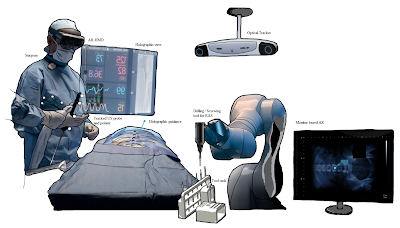Article intro - XR and Robot-Assisted Surgery for Pedicle Screw Placement
Abstract
Background: This article provides a scoping review on the current status of Image-Guided Navigation with various forms of digital technologies, including Extended Reality, Augmented Reality Head-Mounted Displays (AR–HMDs) and Robot-Assisted Surgery (RAS) for Pedicle Screw Placement in orthopedics and spine surgery. Methods: A scoping literature review was performed in the PubMed, Scopus, Embase, Web of Science, Google Scholar and IEEE Xplore databases to collect clinical and user satisfaction data on AR–HMDs and compare those with RAS outcomes. In vivo patient, cadaver and phantom trial accuracy data reports were identified and grouped through the analysis. Over the past two years, 14 publications were retrieved and analyzed. Pedicle screw placement accuracy was described with Linear Tip Error (LTE), Angular Trajectory Error (ATE) and Gertzbein–Robbins Scale (GRS) outcomes. Results: The Pedicle Screw Placement accuracy was seen to increase in the in vivo, cadaver and phantom model groups using AR-HMD compared to the Free-Hand insertion technique. User experience and satisfaction data were limited; however, a clear advantage for the operative results was described when it was added. RAS screwing showed similar accuracy outcomes. The need for benchmarking and quantified situation awareness for AR–HMDs is recognizable. The authors present a method for standardized scoring and visualization of surgical navigation technologies, based on measurements of the surgeon (as the end-users) user satisfaction, clinical accuracy and operation time. Conclusions: computer-technology driven support for spine surgery is well-established and efficient for certain procedures. As a more affordable option next to RAS, AR–HMD navigation has reached technological readiness for surgical use. Ergonomics and usability improvements are needed to match the potential of RAS/XR in human surgeries.
Source: MDPI Robotics




Comments